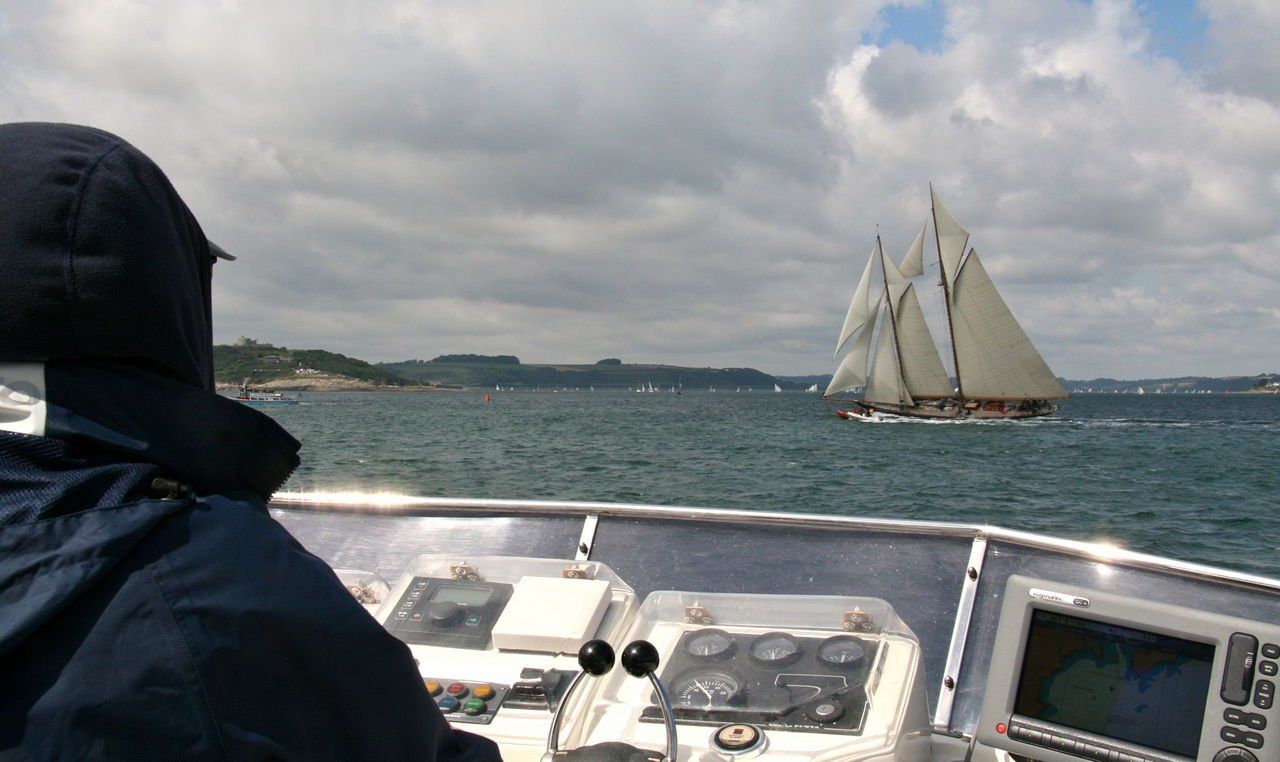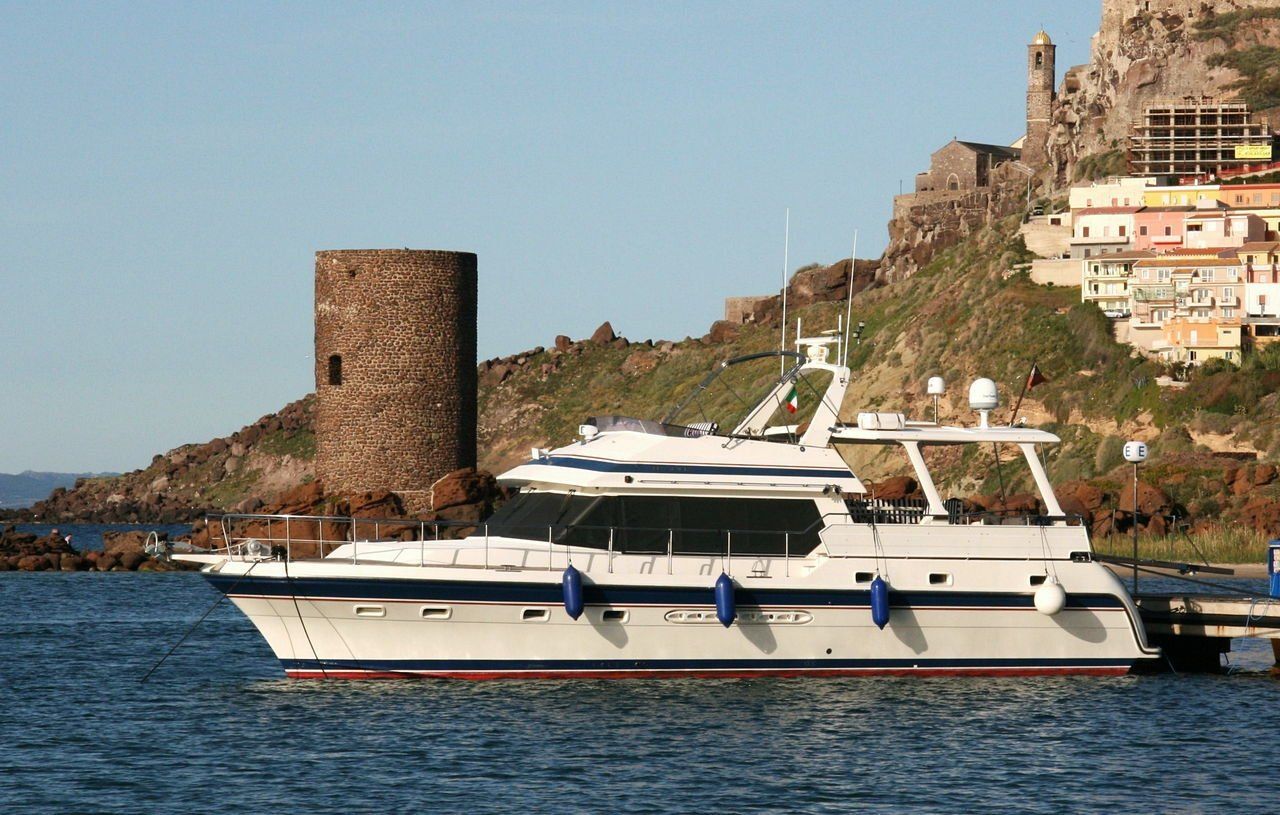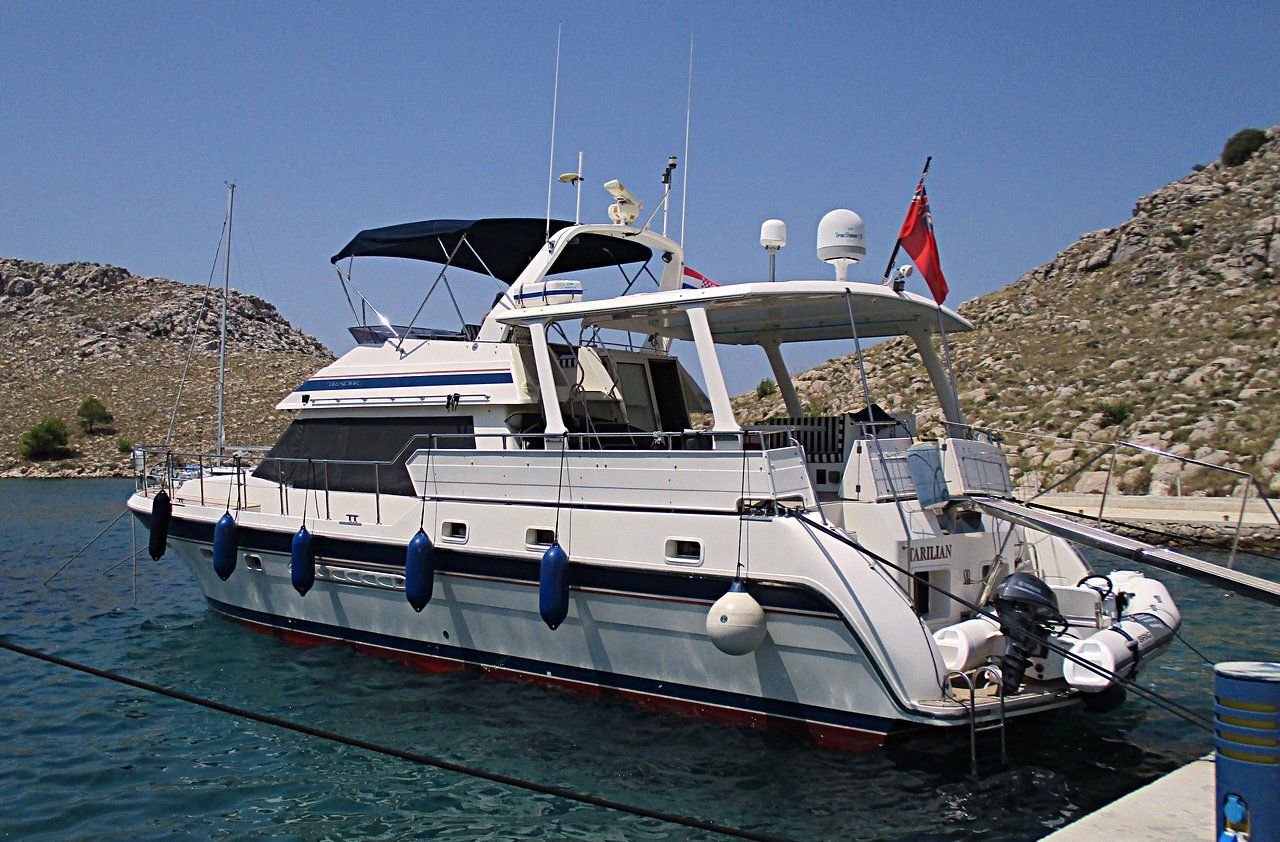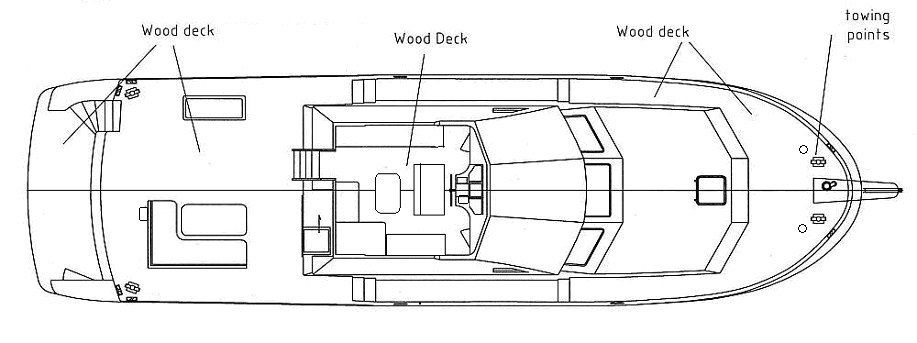The Boat: Tarilian - Trader 535
ABOUT THE BOAT
Tarilian
is a
Trader 535 Signature, a trawler style semi-displacement motor yacht with flybridge, full width aft cabin and covered aft deck.
The 'Trader' range are traditional cruising yachts. Their looks and design, which originated in the 1980s, are clearly more purposeful than trendy. Boats and tastes are all different, but I feel that one does not tire of the boat's character soon; it's rather getting classic as time passes than going out of fashion.
'Trader' yachts were designed by Toby Chappell of Tarquin Motor Yachts (UK), and built by Kha Shing (Kha Shing Enterprises) in Taiwan.
This model has been given Design Category "A" Offshore.
Tarilian was built and first launched in 2000.
Trader 535 dimensions:
Moulded hull length 16.3m (53.5ft)
L.O.A. approx. 17m (56.0ft)
L.W.L. 14.7m (48.2ft)
Beam 4.6m (15 ft)
Draft 1.5m (5.1 ft)
Displacement 24.000 kg (estimated)
Fuel 2400 ltr (in 2 tanks)
Water 910 ltr
Engines 2x Diesel Volvo TAMD73 EDC 430 HP
Generator Onan 12kW. Charger/inverter.
For Mediterranean cruising and the enjoyment of the water, there is an aft platform which is accessed via a comfortable stair case from the aft deck. The boat has air-conditioning to all cabins (4 units), and a hydraulic gangway which doubles as a dinghy crane.
Tarilian is equipped with all usual navigation electronics and safety equipment for offshore passages.
Our Trader T535 is a seaworthy and commodious cruiser and comfortable live-aboard, which can be handled by a cruising couple.
It's neither a fast boat nor a yacht suitable for ocean-crossing.
Tarilian is able to reach a top speed of 18 kn. In practise, the cruising speed is between 8.5 to 11 kn, and gives good fuel economy.
At 8.5kn (displacement speed): 3.5 ltrs/nm, at 9-9.5kn: 4 ltrs/nm, at 10-10.5kn: 5 ltrs/nm, and 10.5-11kn: 5.5 ltrs/nm. The corresponding safe cruising ranges are about 550 nm at 9 kn, and 350 nm at 11 kn. Due to the semi-displacement hull, higher speed will lead to higher fuel consumption per mile.
In general, we find cruising at around 10 kn convenient; but often go at calm 8.5 to 9 kn over shorter distances, and also, when going against wind and swell to reduce spray.
A Walk around the Boat
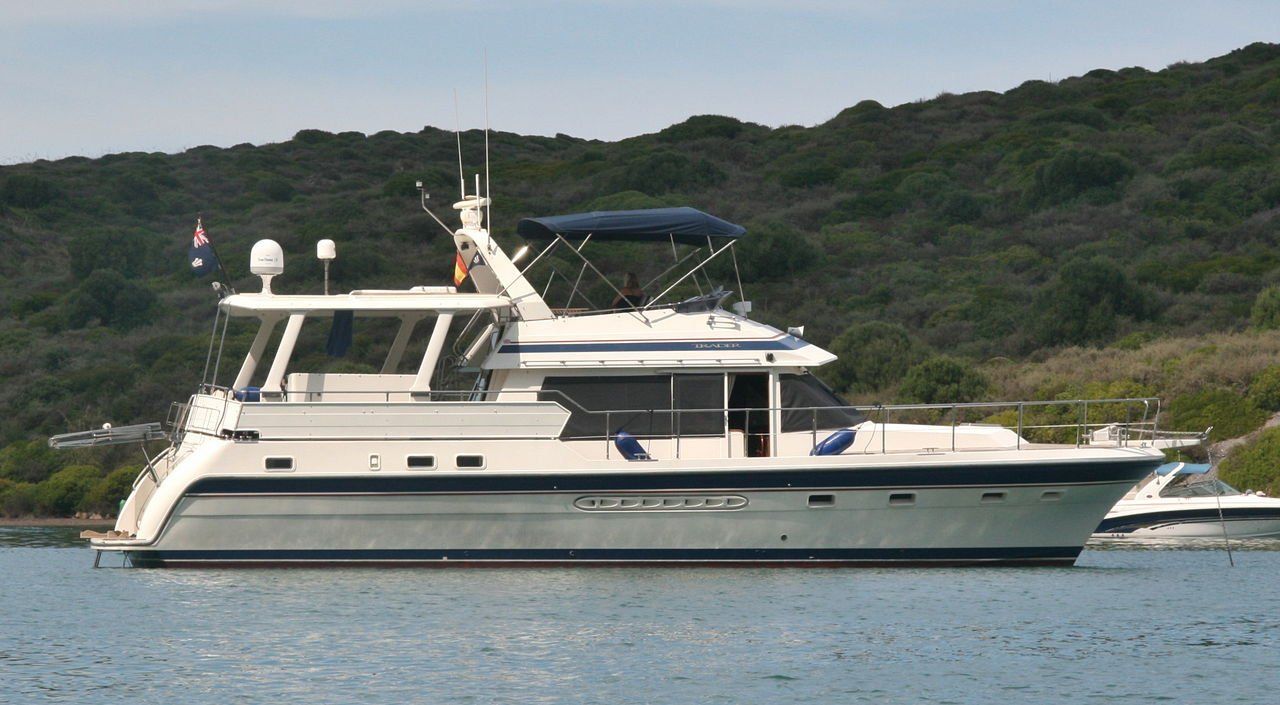
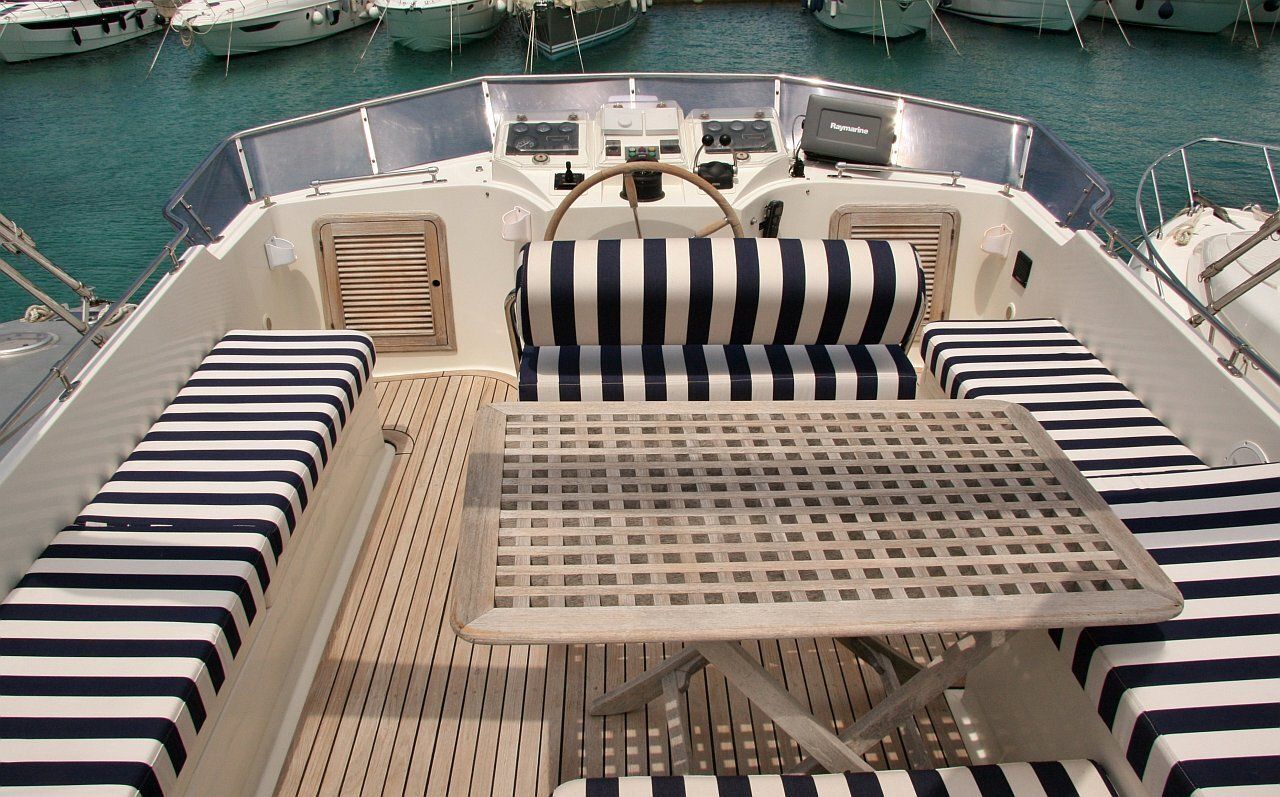
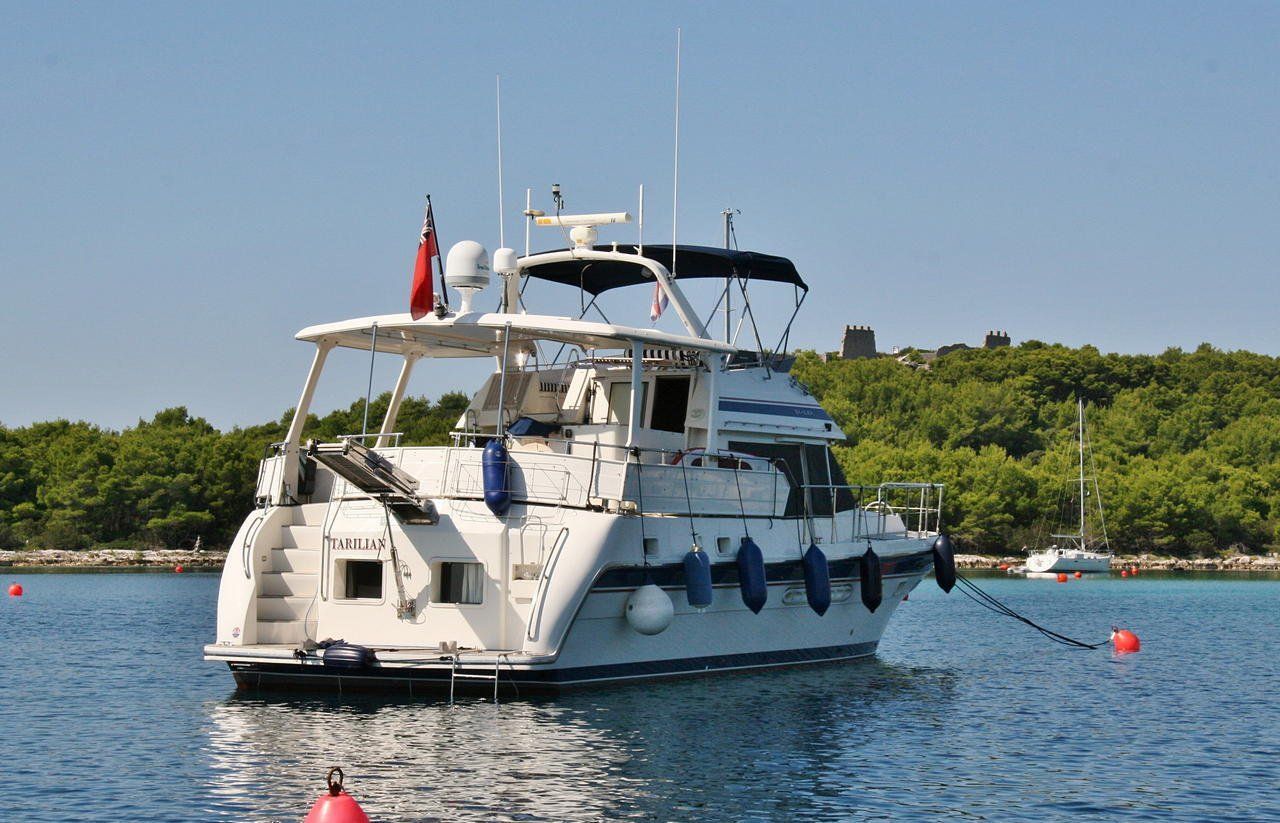
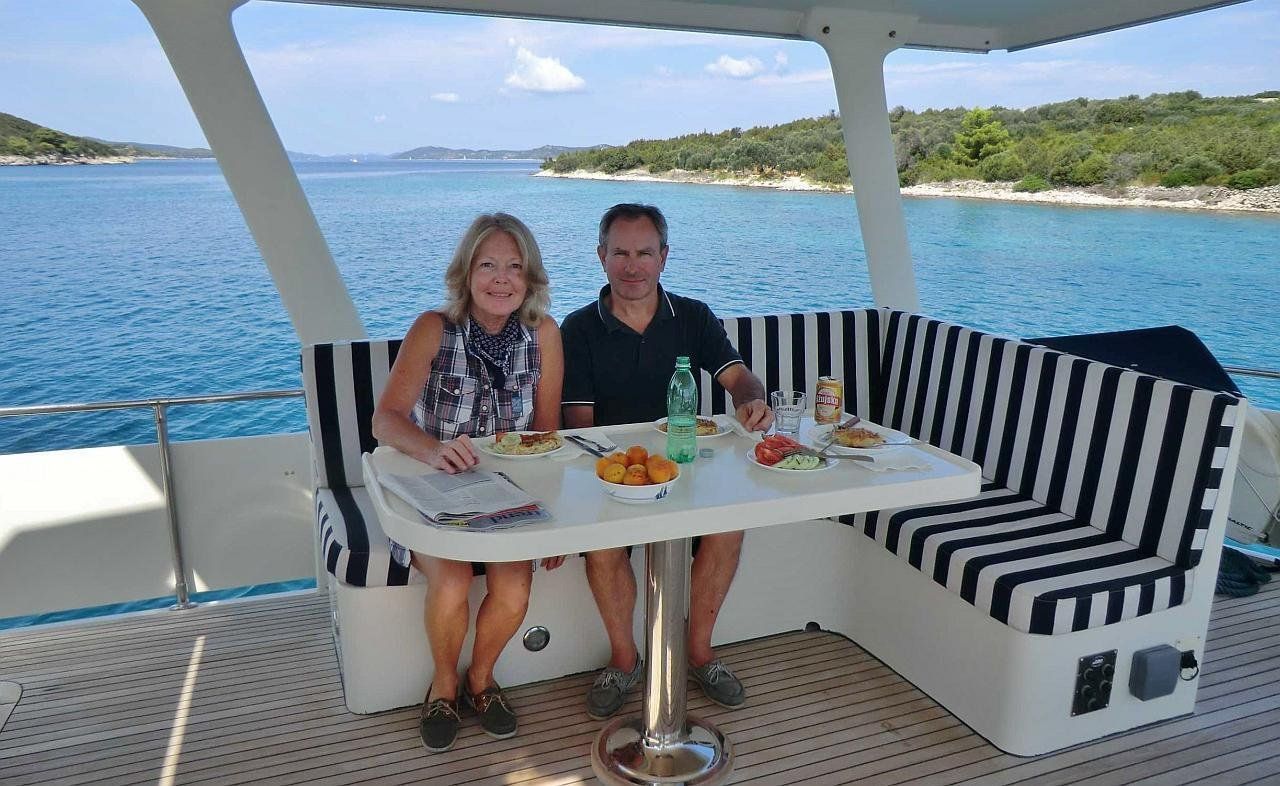
From the aft deck a door and staircase lead into the saloon. Ceiling height is a convenient 6ft7'+ (200+ cm) throughout the boat.
But, taking the stairs too hastily can still bear a small risk of knocking your head.
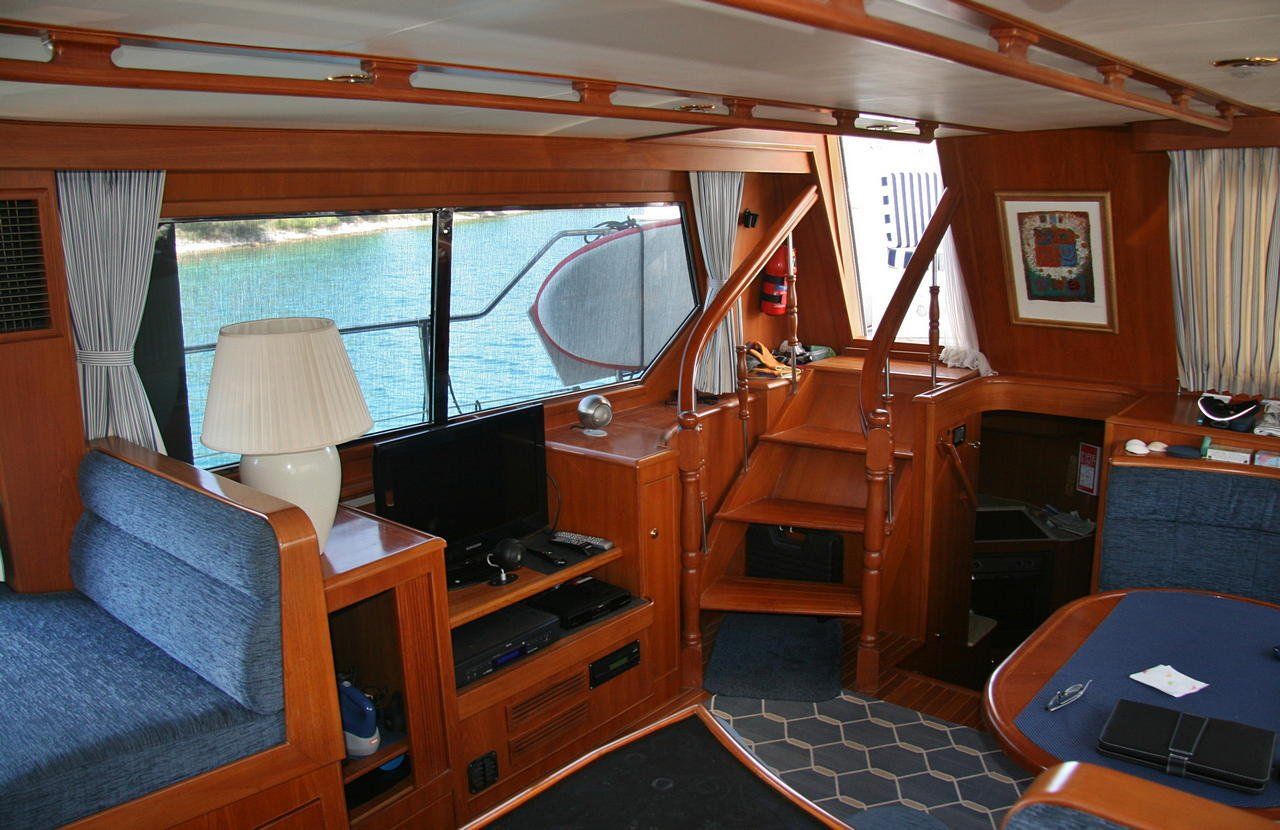
The saloon includes the interior helm to starboard, the driver seat next to the side door, and a navigator seat to port, with a large chart table in front. Anyhow, the interior helm is rarely used by us 'fair-weather sailors'. It's much quieter on the flybridge, too.
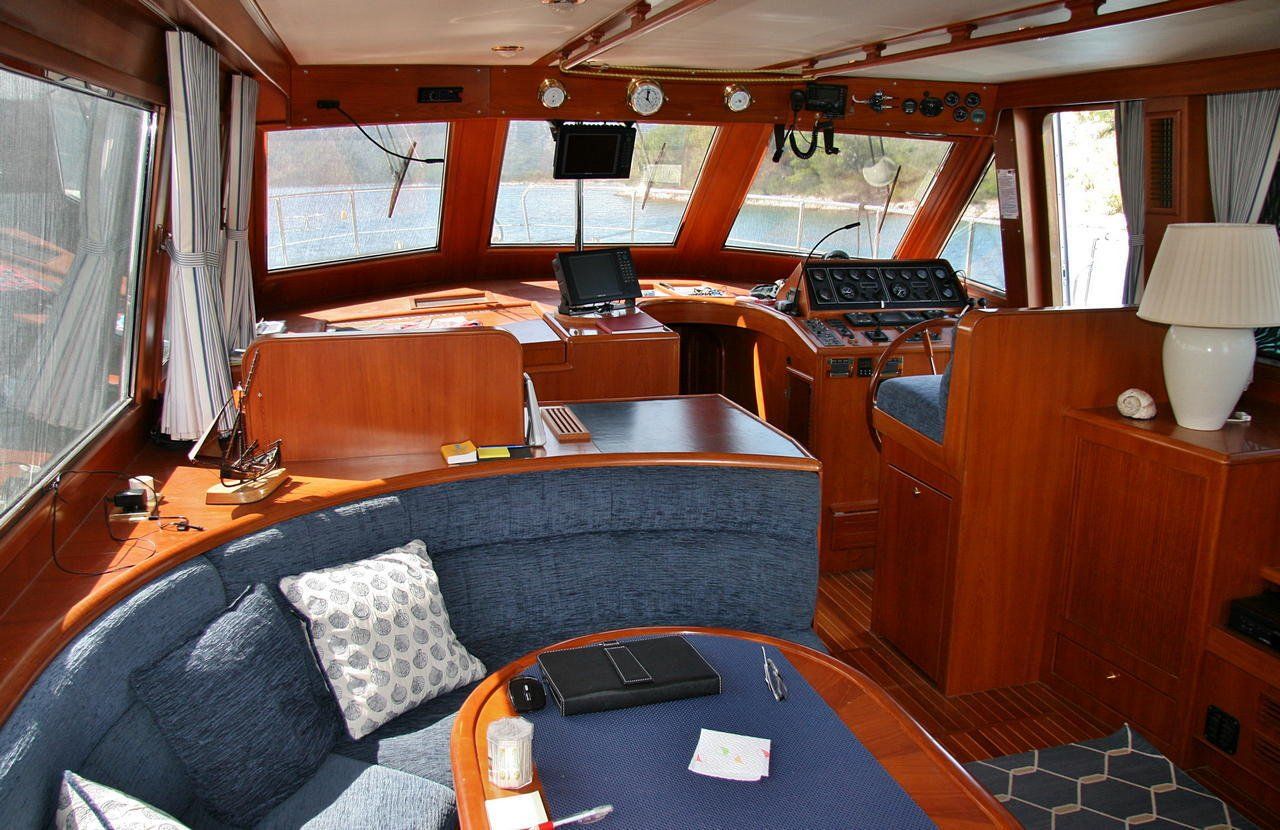
The galley is located downstairs to rear. It has space for household size equipment, proper work surfaces and a range of eye level cupboards, and is fitted with a fridge, freezer, microwave, dishwasher and washing machine.


The full width master cabin (aft cabin) is one of the boat's boons, it offers a walk around king size bed, two large wardrobes, plenty of storage cupboards and drawers, a side seat and cosmetic table, and an ensuite bathroom with a separated small bath tub.
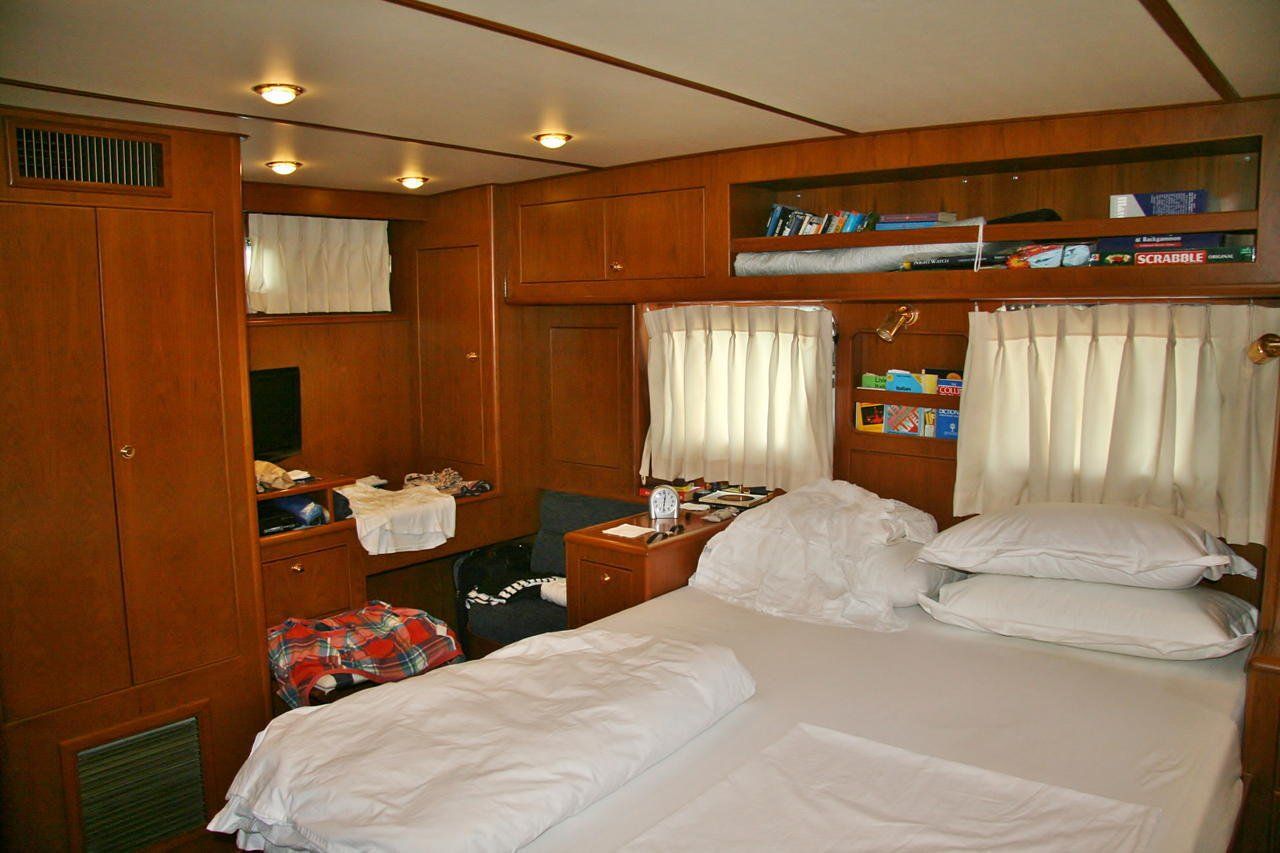
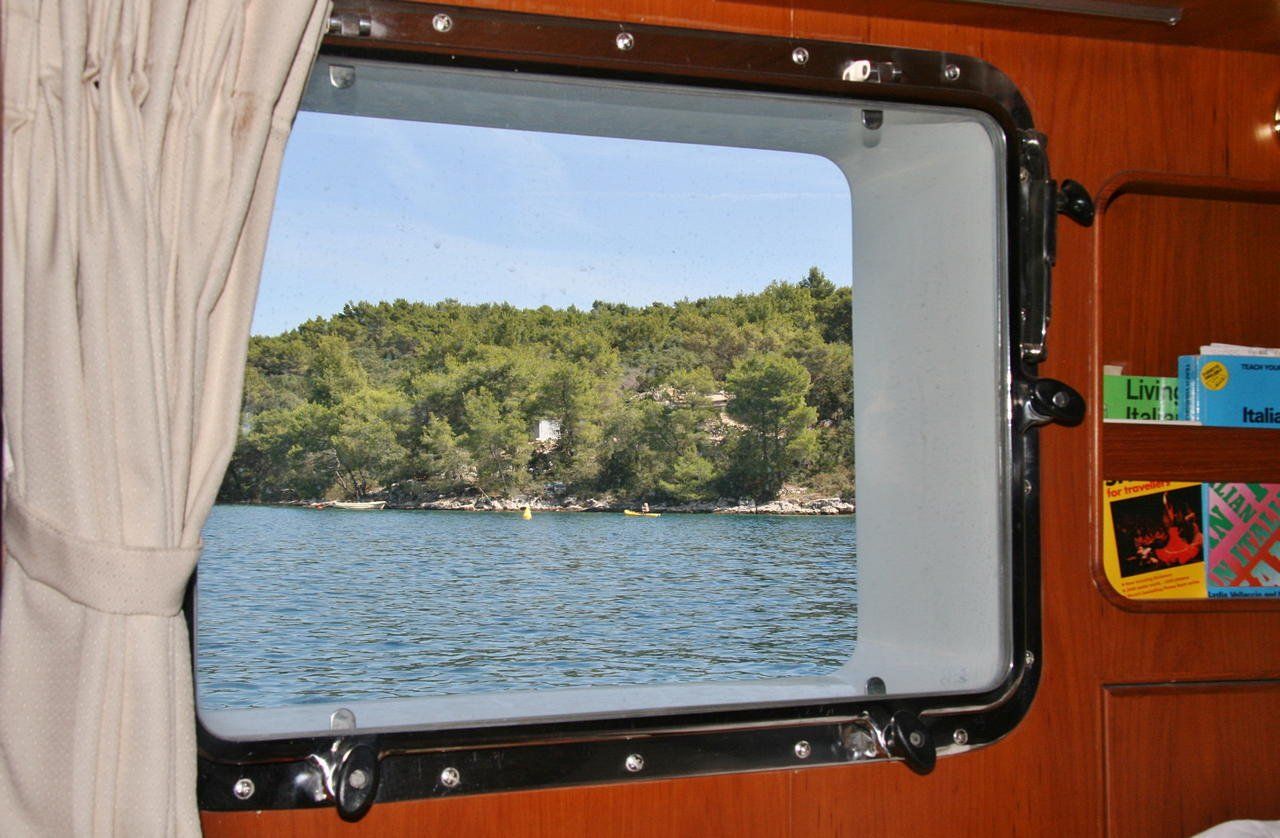
In the forward part of the boat is a substantial bow cabin, also with a king size double bed, a twin bed side (guest) cabin to port, and a toilet/ bathroom to starboard.
My 'office conversion': I had one of the two single beds in the side cabin (3rd cabin) converted to provide an ample writing/computer desk with drawers under. If it was ever needed, the space could still be used as a bed.
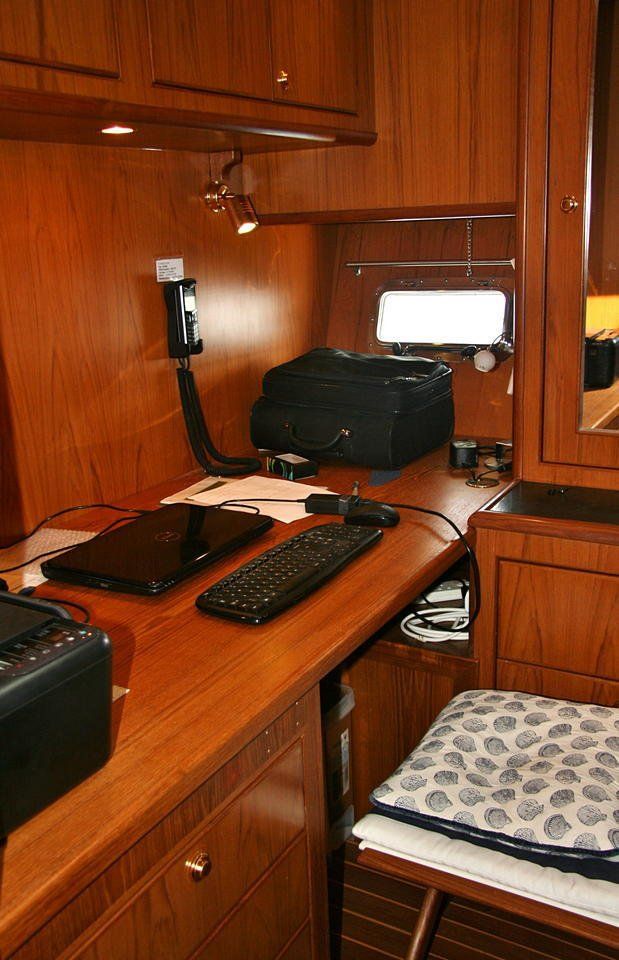
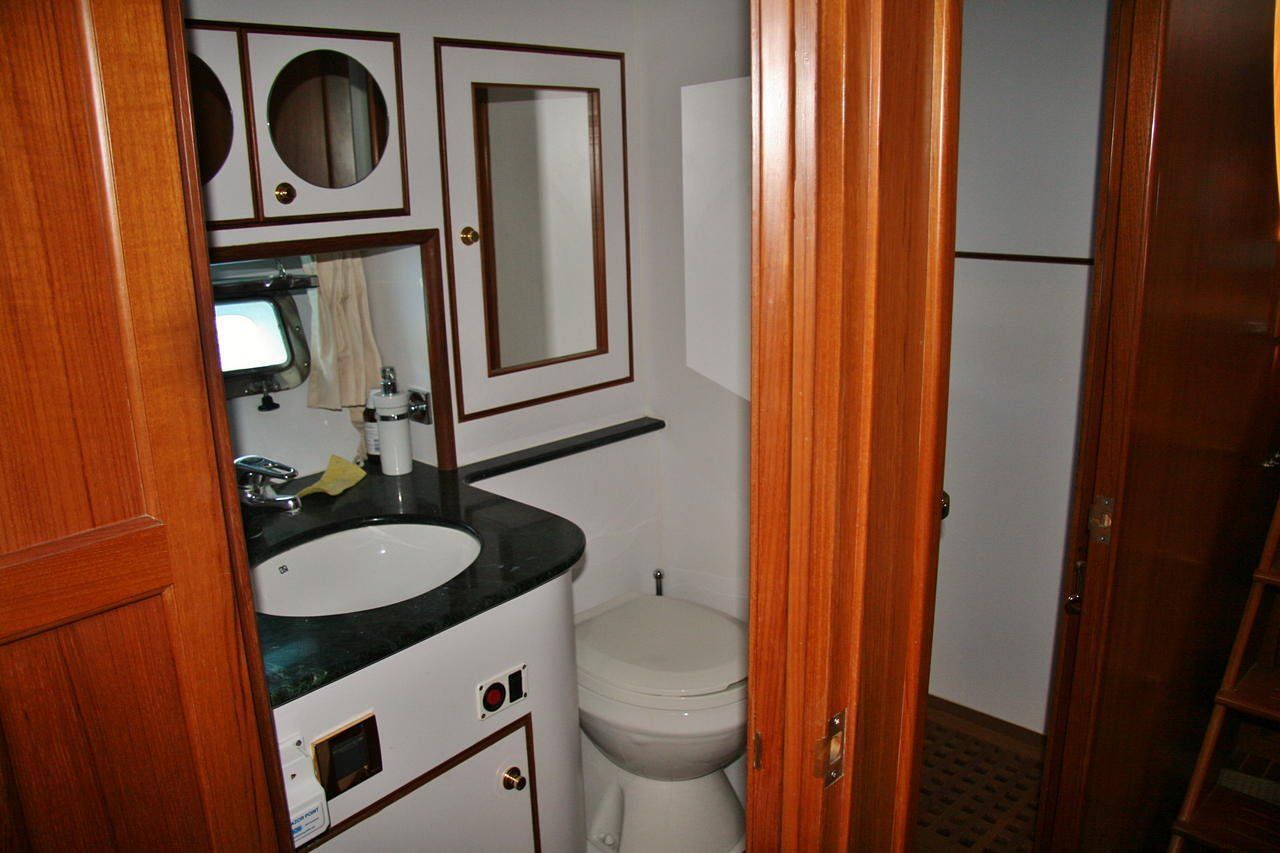
For those who want to know it all: The engine room is below the saloon floor.
There are access doors from the galley and the front corridor; for larger service access there are two lifting hatches in the saloon.
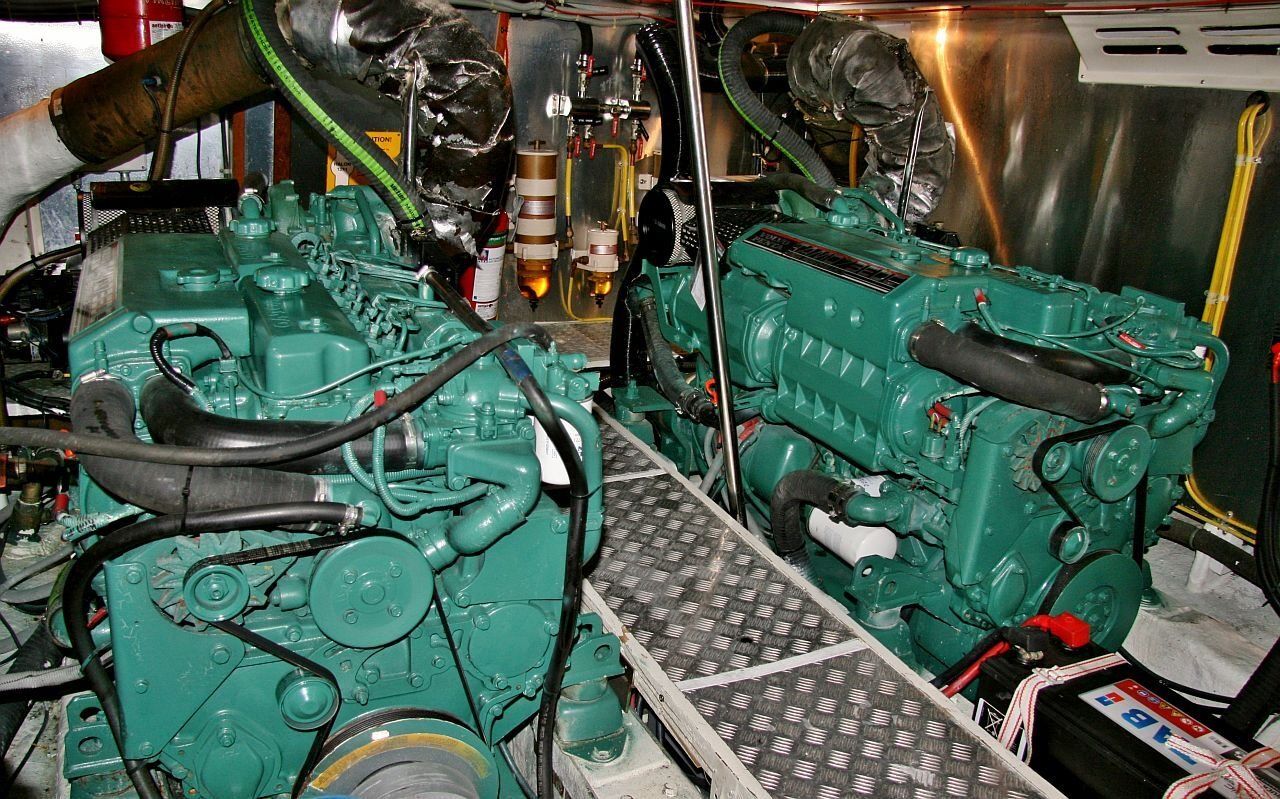

Buying Tarilian: The Background, the Selection, and the Major Works
Before buying this boat in 2009 I had done my homework and been monitoring the used boats market on the web for more than two years; new and nearly new boats were out of my financial reach. I had owned boats before and had skippered a number of chartered vessels in the Med. We had experience with a range of planing and semi-displacement flybridge yachts and sport cruisers.
Our own cruiser for the Med should offer comfortable live-aboard quality for a couple and be kitted out to suit our needs better than a charter boat, and extend our cruising range. Our aim was to do coastal cruising in our own time, and to stay in places we liked.
I preferred a sturdy 'traditional' boat, on which everything made sense; a flybridge was a must, as was a swimming platform for the Med. We had come to like spacious semi-displacement yachts with good cruising credentials, aft cabin and aft deck, and the comfort of teak decks and high quality woodwork inside.
Why a Trader 535? The 'Classic Trader' (brochure) range, and in particular the 535 models, ticked all the boxes with their blend of traditional trawler and modern features (such as sea stairs and moulded swimming platform), well balanced accommodation, a large aft deck with solid roof above, and wide side decks. At under 17m length over all the 535 is not too large to find a berth in most Med harbours and marinas, but avoids compromises in the spaces on and under deck found with smaller boats and planing hulls. The 535 has been relatively popular, that means there is usually a choice of examples on the used market: Traders are semi-custom boats, each is slightly different, therefore having a choice matters.
At the time, Tarquin Trader Yachts, based on the UK south coast, further helped to us to learn more about their boats and compare different models.
With the home work done, clear preferences and an overall budget worked out, it was easy for me to narrow the number of boats to view down to just three or four as soon as I was in the position to make a cash offer and go ahead with the purchase.
Why buying it in the UK? It might have seemed more practical and maybe cheaper to buy a boat for the Med that is already in the area. I explored this, but the availability of several examples to choose from was in favour of the UK. Also, I wanted to manage the refurbishing works myself. Living in London, working with UK yards and contractors in such a project is just far more efficient than with companies abroad; the same is true for finally kitting the boat out and trying it nearer to home. In hindsight, it also gave us the opportunity for an epic journey to the final cruising destination; just the kind of trip those boats are very capable of.
We found
Tarilian, a 535 Signature model of early 2000, pleasing on and under deck; saloon and flybridge layout suited our requirements as a cruising couple very well; I was familiar with Volvo engines from my previous boats, and, the asking price seemed fair.
I bought her from her first owners in Falmouth in autumn 2009; she had been dry stored at the yard for some time waiting for a new owner.
Tarilian had been cruised in Spain and driven back to Falmouth; the boat had a good general specification, including a passarella and air conditioning, and appeared to be in sound condition. However, after 10 years she obviously needed substantial refits and upgrades to bring her up to the standard and specification of newer boats.
Before the
re-launch in May 2010 I commissioned a
comprehensive overhaul of the mechanical and electrical/electronic systems. Plumbing, board electrics, including a new inverter, navigation electronics and a number of instruments were refitted to current standards respectively added; diesel heaters and satellite broadband were installed.
Extra cleats and grab rails were made for safety and ease of use. A boarding ladder for the side deck gates was custom made.
Nylon couplings were fitted to the shafts, and rope cutters to the propellors.
The side (3rd) cabin was modified to become my skipper's cabin with an ample writing/computer desk.
In 2010 Tarilian also received full sets of new cushions, curtains, mattresses and all outside covers; and, finally, a new console rib tender.
As part of the works I had also specified some
customization based on my Med experience:
For Mediterranean style stern-to docking, in particular when short-handed, I wanted a third helm station on the aft deck.
The L-shaped moulded
aft deck settee
had been factory fitted right on the starboard edge of the aft deck; it needed to be moved towards the centre, and a little forward, to allow passing behind along the rails when picking up and taking the (usually heavy and muddy) mooring line (ground rope) from stern to bow, and to give more space for managing shore lines.

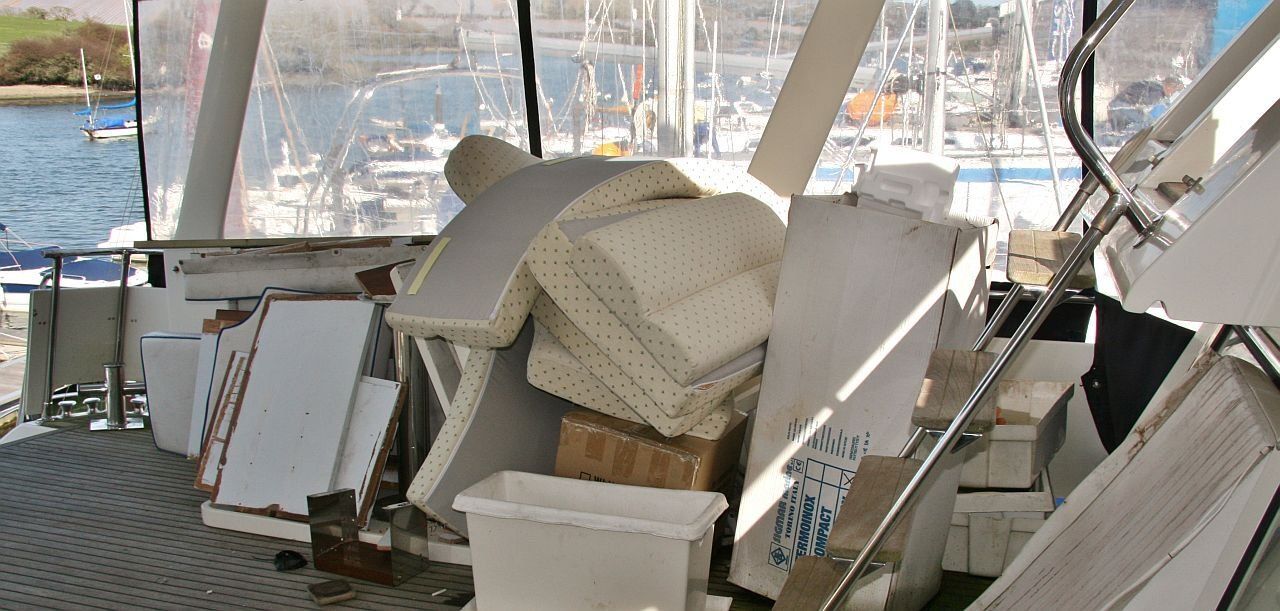
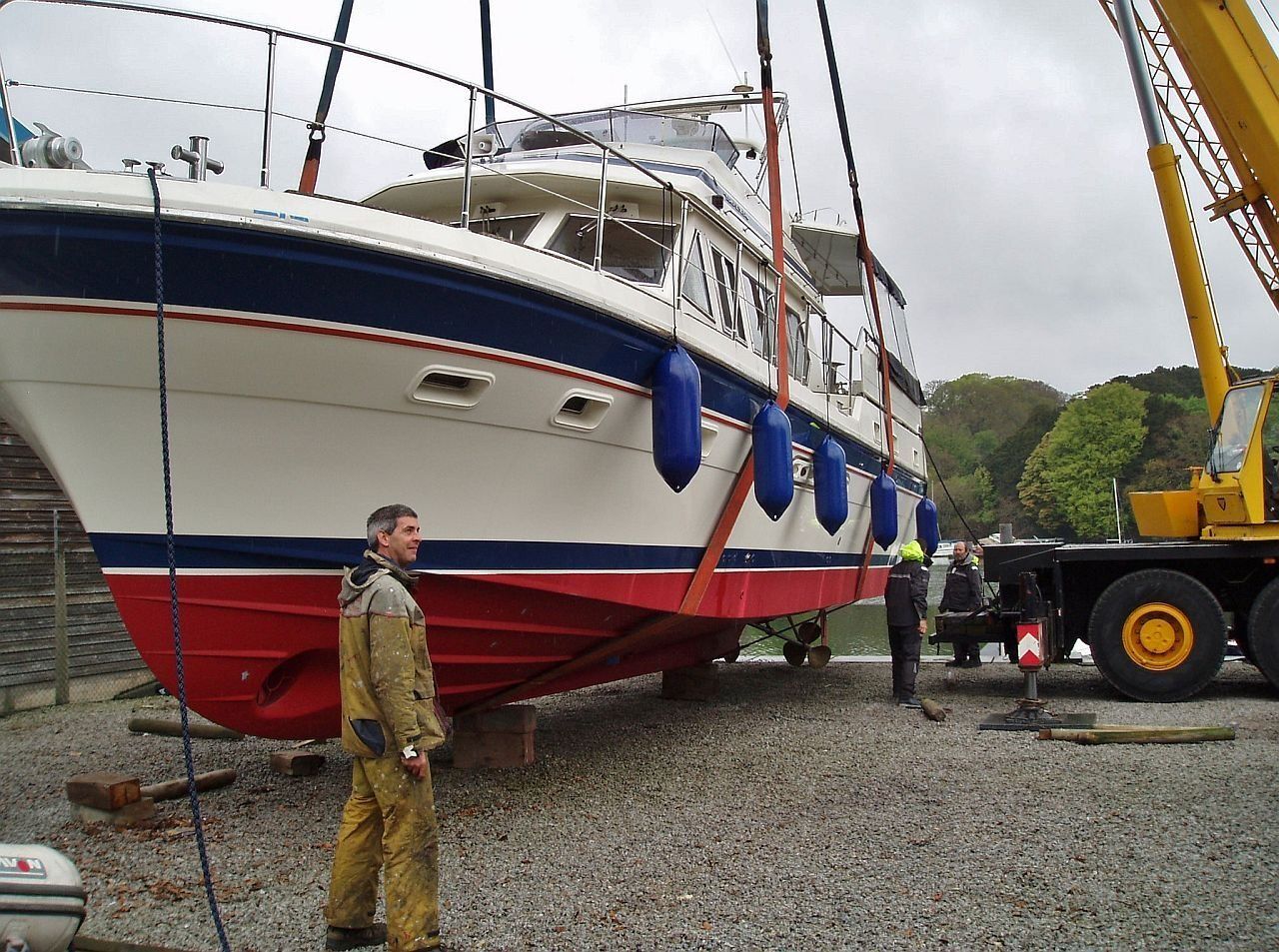
Experience after several years of ownership; maintenance, replacements and upgrades
The boat has certainly kept its promises and been suiting and exceeding our requirements as a cruising couple, and occasionally with a guest. We have never felt a lack of space or comfort, and living on board for three weeks or so at a time is a pleasure; I know other owners who stay even longer. Tarilian has become our very personalized home for those best periods of the year.
Even after years of ownership and looking at other, recent, models, I have not found any that could offer as generous covered outdoor spaces and satisfactory accommodation at the same length as this one.
Tarilian has proven capable of relaxed and steady passage making. Though not fitted with the biggest engine option for this model, I find them perfectly suited to the character of the boat and always offering plenty reserves of power. Whilst the boat does not provide sporty handling or the frightening excitement of planing speeds (we aren't looking for that), cruising is much faster than on displacement-only vessels.
There is a point to grumble over specifically regarding the Trader 535:
The
Trader hull, with its traditional semi displacement shape, has a tendency to
roll in seas from abeam and aft quarters. It is more of concern for passages in the long Atlantic swell than in the Med, and it's about comfort rather than safety. Although there is nowadays an increasing marketing pitch on stabilizers for smaller boats, retro-fitting stabilizers to Tarilian would neither be technically easy nor affordable to me. I am carefully avoiding such sea conditions when planning a passage. As a leisure skipper I insist on - and can afford - taking time and waiting for a favourable forecast rather than putting the crew at risk of any prolonged dodgy ride.
Note: Additional load high up on the boat increases its tendency to roll. Tarilian is a Signature model, its aft deck hardtop is held up by posts, there is no tender crane, the dinghy is carried on the aft platform. Trader's Sunliner model has a stronger hard top that is integrated with the superstructure, and a tender crane. However, storing a heavy dinghy at this height on the boat should be carefully considered from the point of stability in heavy seas.
Regarding running costs; the much talked about fuel consumption of motor boats is not so bad in case of Tarilian: Based on our average annual usage, the cost of fuel (around 4 ltrs/nm) amounts to only a moderate percentage of the total annual costs of boating, 10-15%. The lion share of 85-90% of costs goes towards berthing fees, annual maintenance, repairs/renewals and upgrades, not to forget insurance. Costs of labour and yard costs, such as craning, are going up year on year.
At this point a personal comment about my experience during cruises: To keep everything on a sizeable boat in good condition and working order (without employing a professional skipper), the single handed owner operator has to be ready to act as cleaner, handyman, trouble shooter, electrician, and even ad hoc mechanic or plumber when need arises. Need keeps arising, it's a boat! By the nature of cruising, service men are hardly ever available at the time and place you want them. Magazines and books do not prepare you for it; you learn by practical experience. Of course, all boats are different, and, it is up to the skipper how much or little he does, but it might show.
--------------------------
After the initial major works in Falmouth in 2010 I have
continued with updates and improvements based on experience:
An upgraded anchor (Rocna); a custom made teakwood door to the aft deck locker; underwater lights (yes, nice in a bay for a night swim!); courtesy and stair lights inside and out (for safety); winches for mooring ropes on the bow; bilge alarm; sun covers to protect the aft deck settee, and more.
It goes without saying that annual engine and generator servicing, antifouling and routine maintenance are being carried out in the spring ahead of each season.In spring 2015 I commissioned
a major service
of the Volvo engines.
All needs for repairs/replacements are being addressed as they arise, hopefully without causing disruption to holiday plans.
Further issues we experienced in the course of using the boat, and the solutions we chose:
A Trader 535 is a tall boat with
high windage. For stern-to Med mooring under side wind, a
stern thruster helps - particularly if you are cruising short-handed as we do. Previously, in the UK, I had seen this an unnecessary extra for a boat like ours. However, after repeated stressful mooring situations under wind in Croatia, I do feel it is needed for safety and for the additional degree of control during close quarters manoeuvres that helps reducing risks and stress.
I had one fitted as part of the annual pre-season works in spring 2017.
At that time I also had
the front teak deck refitted which had been in the weather since the boat's launch in 2000 and had started to deteriorate
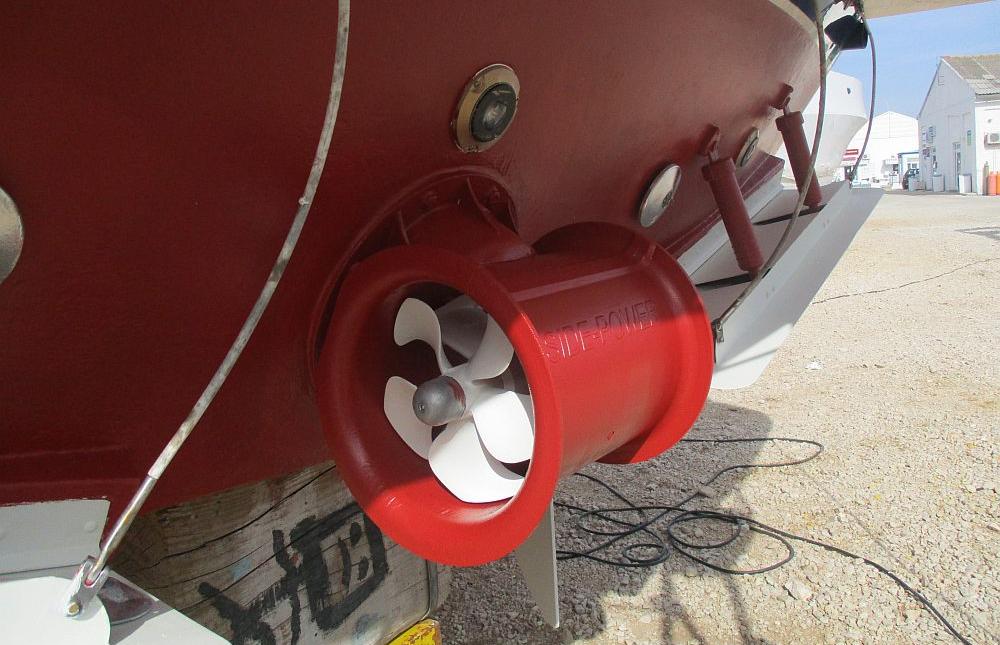
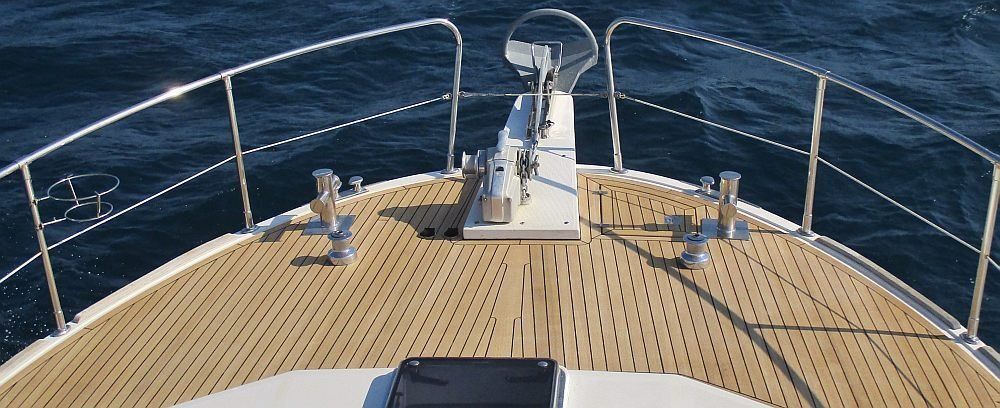
The dinghy & swimming ladder issue
On a Trader 535, the original swimming ladder is a substantial swivelling L-shaped ladder. On Tarilian, it is on the starboard side of the swim platform. When stored, the part on deck rests on the aft platform and the part which goes into the water leans against the transom, where there is also the deck shower. This arrangement means, that it can only be put into the water when there is no dinghy on the platform. I had realized this being an issue, and had fitted a small auxiliary telescopic ladder underneath the platform nearer to the port side corner.
Our 3.1m Walker Bay console
rib tender was chosen in the UK to fit fine on the aft platform of a Trader 535 Signature; but it 'filled' the platform to its edges. The outboard's prop shaft was in the way and made getting to the auxiliary swimming ladder, to go for a swim with the dinghy still on the platform, a struggle for anyone other than the most athletic members of crew.
Looking at other boats around us, I feel that I was not the only Med boater who had such a problem.
By the end of 2016, after six seasons, the Walker Bay tubes had suffered damage from the sun and become unsightly.
I was adamant that the replacement should be an equally capable console tender, just a little shorter so there would be space behind it to get to the ladder; I went for an affordable model from Brig, and for an outboard engine with electronic fuel injection for reliable starting.
To complete the convenient swimming arrangement, I had an additional 'swimming pool style'
bathing ladder custom-made to go on the corner of the aft platform. When not in use it has its place on the aft deck.
In the following year an additional small deck shower was put in by the staircase for easy access.
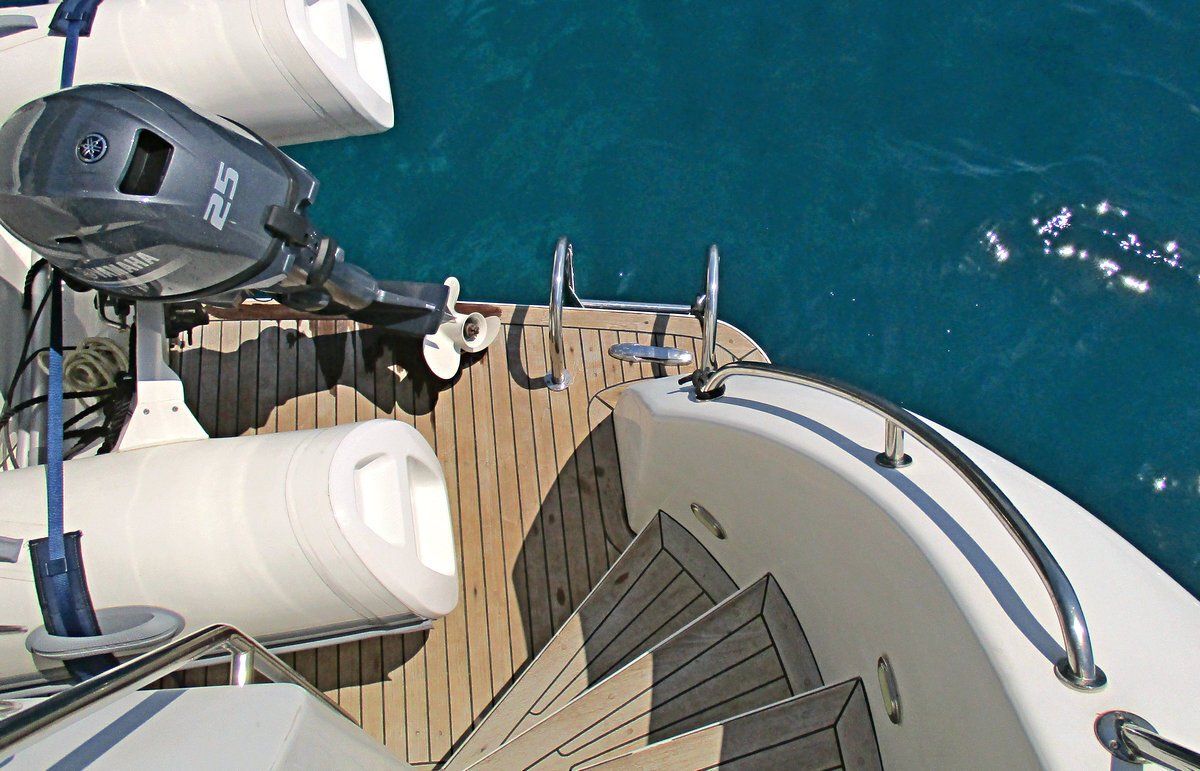
One of the pleasures of boating is to spend days in a bay, or on moorings with no shore power. I feel that having to run the generator for hours every day, just to replenish the energy used by two fridges and other equipment over 24 hours, is inconvenient. As part of the
2018
pre-season works I had a set of
solar panels fitted. They certainly help, but I note that the practically achieved charging performance of this installation is far lower than I had hoped. It seems that a partial shadow on a panel leads to significant reduction of its efficacy.
At the same time the outdated sat TV antenna, which had become unreliable, was replaced with a future-proof KNS unit (DVB-S2, GPS auto-scew).
Furthermore,
a 4G mobile aerial
was installed on the radar arch to improve reception of the mobile wi-fi router. The aerial, plus a suitable UK data roaming SIM, provide good coverage of high-speed on-board wi-fi and access to the same streaming content as at home.
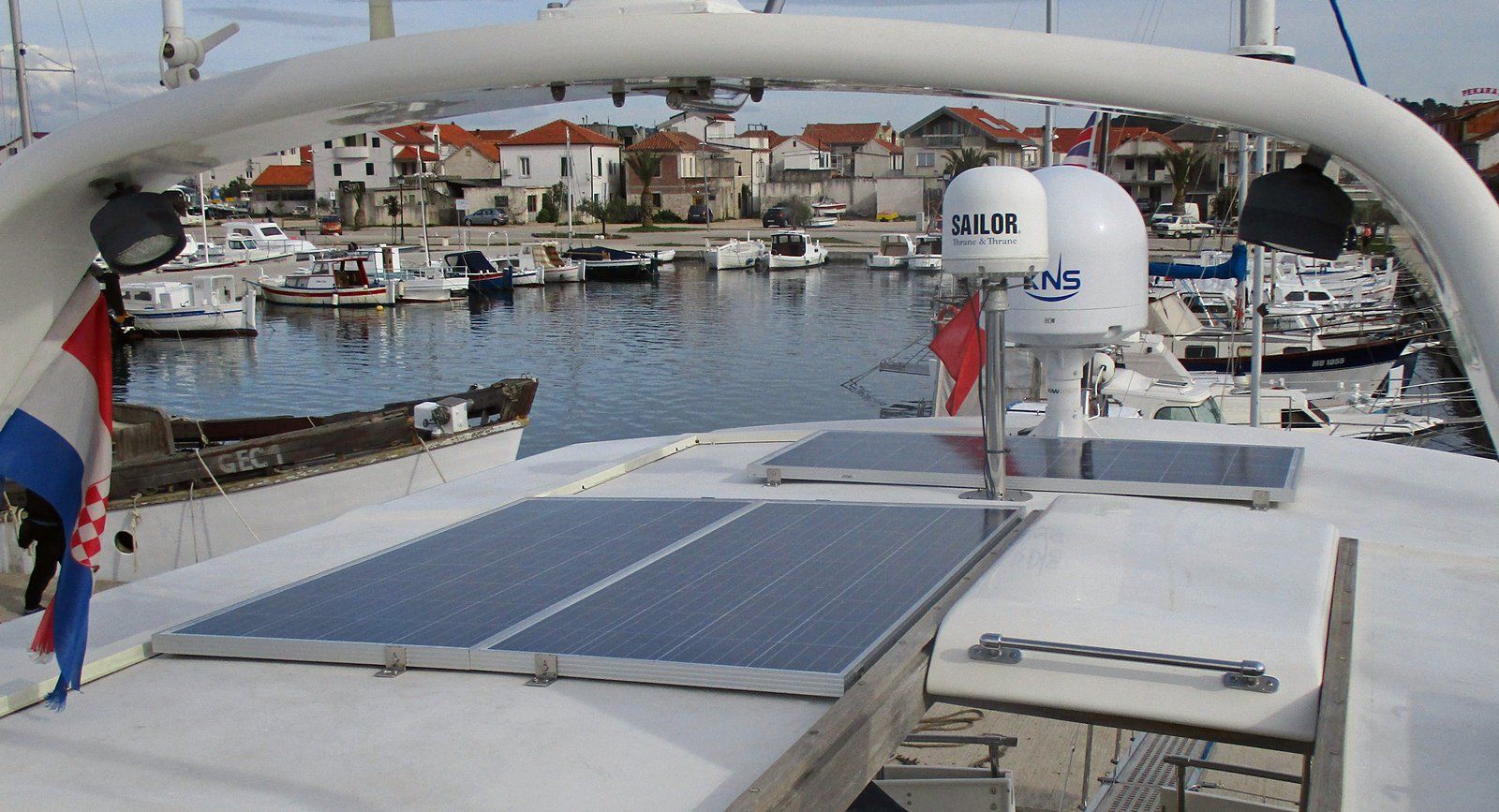
Time passes quickly
By 2020, it's 20 years since Tarilian was first launched and 10 years since the refit in Falmouth.
Superyachts get refurbished every few years, but ordinary motor cruisers often go without cosmetic updates for a long time.
Tarilian's looks have generally kept up well. For her age, her original condition is fine and nothing is urgently needed to continue enjoying the boat.
However, environment and med sun have been at work for a good while; on closer inspection some cracks and imperfections in gelcoat and paint are noted. A refurbishing program should be considered.
You are welcome to provide feedback, see contact
SOME PHOTOS FROM EARLIER YEARS
